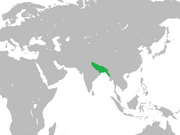
Flag of Bengal Sultanate 1352 AD/CE to 1576 AD/CE
Capitals: Pandua, Sonargaon, Gaur, Tandah

Continent: Asia
Official Languages: Persian, Bengali, Arabic
Established: 1352 AD/CE
Disestablished: 1576 AD/CE
History:
Ilyas Shah established his capital in Pandua. He unified the delta of Ganges, Brahmaputra and Meghna Rivers into the Sultanate of Bengal. Ilyas Shah waged wars and raids against several city-states and kingdoms in the eastern subcontinent. He conquered eastern Bengal and northern Bihar. He led the first Muslim army into Nepal, raided the Kathmandu Valley, and returned to Bengal with treasures. He controlled an area stretching from Assam in the east to Varanasi in the west. In 1353, Ilyas Shah was defeated by Delhi Sultan Firuz Shah Tughluq in the Siege of Ekdala Fort during the Bengal Sultanate-Delhi Sultanate War. Bengal agreed to pay a tribute to the Delhi Sultan. Despite losing control of many conquered areas, Ilyas Shah remained in firm control of Bengal.
Ilyas Shah founded the Indo-Turkic Ilyas Shahi dynasty which ruled Bengal for fifteen decades. His son and successor Sikandar Shah defeated Delhi Sultan Firuz Shah Tughluq during the second Siege of Ekdala Fort in 1359. A peace treaty was signed between Delhi and Bengal, with the former recognizing the independence of the latter. Firuz Shah Tughluq gave a golden crown estimated to be worth 80,000 taka to Sikandar Shah. The peace treaty ensured Bengal's independence for two centuries.
Sikandar Shah's reign lasted for three decades. The Adina Mosque was built during his reign. The mosque's design was based on the Great Mosque of Damascus- a style used during the introduction of Islam in new areas. During this time, much of the agricultural land was controlled by Hindu zamindars, which caused tensions with Muslim taluqdars.
Bengal became the eastern frontier kingdom among medieval Islamic states. In the 14th-century, Islamic kingdoms stretched from Muslim Spain in the west to the Indian subcontinent in the east. The Islamic kingdoms had multiethnic elites. Persian and Arabic were used alongside local languages. Persian was used as a diplomatic and commercial language. Arabic was the liturgical language of the clergy. In Bengal, the Bengali language became a court language and was the main vernacular language under Muslim rule.
The third Sultan Ghiyasuddin Azam Shah began expanding Bengal's influence abroad. He began to send embassies to Ming China, which continued as a tradition during the reigns of his successors. Ghiyasuddin also sponsored construction projects in Arabia. He exchanged letters and poetry with the Persian poet Hafez. The Bengal Sultans pledged nominal allegiance to the Abbasid Caliphate in Cairo. The coins of the Bengal Sultans often bore the name of the contemporary Abbasid Caliph. Ghiyasuddin Azam Shah held his court in the central Bengali city of Sonargaon, in addition to Pandua. The travel accounts of Chinese envoys state that the Sultan lived in a palace near the river port of Sonargaon. The river port had shipping links to China, Southeast Asia, and the Middle East. In 1406, Ma Huan found Sonargaon as a large metropolis. Other Chinese envoys provided descriptions of a fortified walled city. Sonargaon was a center of Sufi education and Persian literature. Sultan Ghiyasuddin invited Hafez to settle in Sonargaon. The institutions founded by Abu Tawwama during the Delhi Sultanate were maintained by his successors in the Bengal Sultanate, including the Sufi preachers Saiyid Ibrahim Danishmand, Saiyid Arif Billah Muhammad Kamel, Saiyid Muhammad Yusuf and others.
During the early 15th-century, the Ilyas Shahi rule was challenged by Raja Ganesha, a powerful Hindu landowner, who managed to place his son (a convert to Islam), Jalaluddin Muhammad Shah, on the throne. Jalaluddin had a relatively short-lived but significant reign, during which he helped an Arakanese king to achieve the Reconquest of Arakan. Jalaluddin established control over Fatehabad. Jalaluddin also promoted more native Bengali elements into the architecture and governance of the sultanate. Jalaluddin was initially loyal to the Abbasid Caliph but later declared himself as the Caliph in a sign of Bengali Muslim independence. The Ilyas Shahi dynasty was restored in 1432.
Nine kings ruled Bengal from Pandua over the course of ten decades. They built palaces, forts, bridges, mosques, and mausoleums. Chinese envoy Ma Huan described the city at the time in his travel accounts, which state that "the city walls are very imposing, the bazaars well-arranged, the shops side by side, the pillars in orderly rows, they are full of every kind of goods". Pandua was an export center for cloth and wine. At least six varieties of fine muslin and four types of wine were found in Pandua. High-quality paper was produced from the bark of Pandua's mulberry trees. Sultan Mahmud Shah of Bengal shifted the capital from Pandua to Gaur in 1450. One of the probable reasons behind the move was a change in the course of nearby rivers.
The reign of Mahmud Shah witnessed greater control over the Sundarbans. The governor of the Sundarbans, Khan Jahan Ali, built the mint town of Khalifatabad. Like many other officials, Khan Jahan had settled in Bengal after Timur's sack of Delhi. During the reign of Rukunuddin Barbak Shah, the Kingdom of Mrauk U conquered Chittagong. The late 1480s saw four usurper Sultans from the Abyssinian mercenary corps. Tensions between different Muslim communities often affected the sultanate.
Alauddin Hussain Shah gained control of Bengal in 1494 when he was prime minister. He brought end to a period of instability. As Sultan, Hussain Shah ruled till 1519. The dynasty he founded reigned till 1538. Muslims and Hindus jointly served in the royal administration during the Hussain Shahi dynasty. This era is often regarded as the golden age of the Bengal Sultanate, in which Bengali territory included areas of Arakan, Orissa, Tripura, and Assam. Alauddin Hussain Shah conquered large parts of Assam during the Bengal Sultanate-Kamata Kingdom War. He overthrew the Hindu Khen dynasty. He also restored Bengali sovereignty in Chittagong and northern Arakan after the Bengal Sultanate–Kingdom of Mrauk U War of 1512–1516. Hussain Shah minted coins with the proclamation "conqueror of Kamrupa, Kamata, Jajnagar and Orissa". According to an inscription in Sonargaon from 1513, Hussain Shah annexed large parts of the Twipra Kingdom. The Pratapgarh Kingdom came under Bengali suzerainty. Hussain Shah also waged several campaigns against the Gajapati rulers of Orissa and secured control of northern Orissa. Hussain Shah extended Bengali territory in the west beyond Bihar, up to Saran in Jaunpur. The Sultan of Jaunpur took refuge in Bengal after an invasion by the Lodi dynasty of Delhi. The Delhi Sultan attacked Bengal in pursuit of the Jaunpur Sultan. Unable to make headway, the Delhi Sultan withdrew after concluding a peace treaty with Bengal.
Embassies from Portuguese India frequented Bengal after the landing of Vasco Da Gama in the principality of Calicut. Individual Portuguese merchants are recorded to have lived in the Bengal Sultanate's capital of Gaur. Portuguese politics played out in Gaur as a reflection of contradictions in contemporary Portugal. The Portuguese provided vivid descriptions of Gaur. They compared the affluence of Gaur with Lisbon. The city included a citadel, a royal palace and durbar, mosques, houses for the rich, and bustling bazaars. Portuguese historian Castenhada de Lopez described the houses of Gaur as being one-storeyed with ornamental floor tiles, courtyards, and gardens. Gaur was the center of regional politics. The Sultan of Bengal gave permission for establishing the Portuguese settlement in Chittagong. During the period of the Iberian Union, there was no official Portuguese sovereignty over Chittagong. The Portuguese trading post was dominated by pirates who allied with the Arakanese against Bengal.
The absorption of Bengal into the Mughal Empire was a gradual process. It began with the defeat of Bengal forces under Sultan Nasiruddin Nasrat Shah by the first Mughal ruler Babur at the Battle of Ghaghra. The second Mughal ruler Humayun occupied the Bengal capital of Gaur during the invasion of Sher Shah Suri against both the Mughals and Bengal Sultans. Humayun later took refuge in the Safavid Empire in Persia. Sher Shah Suri succeeded in conquering Bengal and began renovating the Grand Trunk Road. The Suri government appointed successive governors to administer Bengal. The third governor Muhammad Khan Sur declared independence after the death of Islam Shah Suri. Muhammad Khan ended the interrupting period of Delhi's rule and re-established the Bengal Sultanate.
The Pashtun Karrani dynasty was the last ruling dynasty of the sultanate. According to the Riyaz-us-Salatin, Sultan Sulaiman Khan Karrani shifted the capital from Gaur to Tanda in 1565. Sulaiman Khan Karrani annexed large parts of Orissa. During his reign, the Bengal Sultanate's territory extended from Koch Bihar in the north to Puri in the south and from the Son River in the west to the Brahmaputra River in the east. The Mughals became determined to bring an end to the expansionism of the Bengal Sultanate; while eager to absorb the Bengal region for its riches. The Battle of Tukaroi in Orissa saw Mughal forces led by Akbar overwhelm the Bengal Sultanate's forces led by the last Sultan Daud Khan Karrani, resulting in the Treaty of Cuttack. Mughal rule formally began with the Battle of Raj Mahal when the last reigning Sultan of Bengal was defeated by the forces of Akbar. The Mughal province of Bengal Subah was created. The eastern deltaic Bhati region remained outside of Mughal control until being absorbed in the early 17th-century. The delta was controlled by a confederation of twelve aristocrats of the former sultanate, who became known as the Twelve Bhuiyans. Their leader was Isa Khan, a former nobleman of the sultanate. The confederation was made up of petty kingdoms. The Mughal government eventually suppressed the remnants of the sultanate in the Bhati area and brought all of Bengal under full Mughal control.